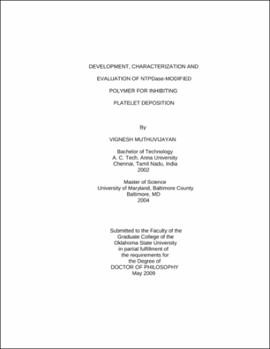| dc.contributor.advisor | Lewis, Randy S. | |
| dc.contributor.author | Muthuvijayan, Vignesh | |
| dc.date.accessioned | 2013-11-26T08:31:41Z | |
| dc.date.available | 2013-11-26T08:31:41Z | |
| dc.date.issued | 2009-05 | |
| dc.identifier.uri | https://hdl.handle.net/11244/7163 | |
| dc.description.abstract | The lack of haemocompatibility in biomaterials is a major concern in blood contacting devices. It causes serious complications such as platelet adhesion and aggregation, thrombosis and shedding of emboli, the latter which could lead to death. According to FDA reports, at least 1510 cases of thrombosis were reported in the year 2008 of which 299 of these cases resulted in death. Improving the haemocompatibility of biomaterials will have a significant impact in lowering these numbers. Furthermore, the market for biomaterials exceeds 100 billion. Improving the functionality of a biomaterial will also have a significant economic impact. Therefore, this research focused on improving the haemocompatibility by utilizing naturally occurring platelet inhibition pathways. NTPDase is a naturally occurring enzyme that rapidly metabolizes ADP to regulate platelet adhesion and aggregation. In this research, polyethylene terephthalate (PET), a model polymer with many blood-contact applications, was modified by covalently attaching NTPDase. The surface and bulk properties of the modified PET were analyzed to verify the potential as a biomedical polymer. Cysteine was also immobilized to PET, along with NTPDase, to take advantage of nitric oxide-mediated platelet inhibition, which has an additive effect on platelet inhibition caused by NTPDase. Findings and Conclusions: NTPDase was successfully immobilized to functionalized PET surfaces. PET surfaces were functionalized by aminolysis, hydrolysis and carboxylation to introduce reactive functional groups. Surface and bulk characterization showed that carboxylated PET has desirable mechanical and surface properties. NTPDase was immobilized to carboxylated and aminolyzed PET. NTPDase immobilization on carboxylated PET was stable and the polymer showed quantifiable NTPDase activity. NTPDase kinetics were studied for free and immobilized NTPDase. In vitro studies using unmodified and modified PET showed that NTPDase attachment significantly improved the haemocompatibility of the polymer. Dual functional polymers were developed by attaching cysteine and NTPDase, simultaneously. However, further research is required to stabilize cysteine attachment. | |
| dc.format | application/pdf | |
| dc.language | en_US | |
| dc.rights | Copyright is held by the author who has granted the Oklahoma State University Library the non-exclusive right to share this material in its institutional repository. Contact Digital Library Services at lib-dls@okstate.edu or 405-744-9161 for the permission policy on the use, reproduction or distribution of this material. | |
| dc.title | Development, characterization and evaluation of NTPDase-modified polymer for inhibiting platelet deposition | |
| dc.contributor.committeeMember | Madihally, Sundararajan V. | |
| dc.contributor.committeeMember | Foutch, Gary Lynn | |
| dc.contributor.committeeMember | High, Karen A. | |
| dc.contributor.committeeMember | Ford, Warren T. | |
| osu.filename | Muthuvijayan_okstate_0664D_10239.pdf | |
| osu.accesstype | Open Access | |
| dc.type.genre | Dissertation | |
| dc.type.material | Text | |
| dc.subject.keywords | hemocompatibility | |
| dc.subject.keywords | immobilized kinetics | |
| dc.subject.keywords | ntpdase | |
| dc.subject.keywords | polyethylene terephthalate | |
| dc.subject.keywords | surface characterization | |
| dc.subject.keywords | surface m | |
| thesis.degree.discipline | Chemical Engineering | |
| thesis.degree.grantor | Oklahoma State University | |
